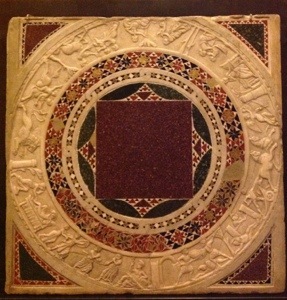Last Friday afternoon I was pootling around the Capitoline Museums, which is the kind of thing guides do on a free off-season afternoon (in case you wondered), when I stumbled upon a piece I’d entirely forgotten was there. A section of a dismantled pulpit from the church of Santa Maria in Aracoeli (just across the square), it was the work of man called Lorenzo di Tebaldo and his son Jacopo and employs an inlay/recycling technique known as “Cosmati work” of which I have long been very fond.

Lorenzo di Tebaldo and Jacopo di Lorenzo, panel from pulpit of Santa Maria in Aracoeli c.1300. Made from rim of 4th basin showing scenes from the life of Achilles, reused porphyry and serpentine, and glass paste. Capitoline Museums.
The name Cosmati does not refer to a specific family (although Jacopo’s grandson was called Cosmas and the generic name may refer to him), but became synonymous with several families of Roman marmorari, or stonemasons, of the late 12th and 13th centuries and the work which they carried out. Regardless of the specific genealogical connections, the common thread in all Cosmati work is the reuse of the grandest materials of the Imperial city.
Columns of purple porphyry from the Eastern deserts of Egypt, green serpentine from the Peloponnese of mainland Greece, and Numidian yellow from the border of modern Tunisia and Algeria were sliced like salami into discs around which triangular chips were arranged in elaborate geometric and serpentine forms inlaid to create pavements and altars, pulpits and bishops’ thrones. To this geological map of the long lost Empire were added coloured glass and gilded tiles. Both the materials and the technique, which merges mosaic and opus sectile, are fundamentally Roman. Indeed Cosmati work was indicative of a sort of mini-Renaissance; a profound “rebirth” inspired by the study of the antique, as well as the art of Byzantium, the Eastern Roman Empire through which that most Roman of arts, mosaic, continued to thrive. Ultimately this spirit of rebirth was to prove a “false dawn”, thwarted by the shift of the seat of the papacy to Avignon just after 1300 which saw Rome’s fragile equilibrium once again spiral into economic and political entropy.
However, before the papacy would abandon Rome to the iniquities of the 14th century, Cosmati work became ever more celebrated. Indeed, such was the fame of the Roman stonemasons that a certain Odericus was called to London by King Henry III to create the floor in front of the high altar at Westminster Abbey which is signed, and dated 1268.
The masons adapted their designs to incorporate cheaper local materials, choosing Purbeck limestone over white marble, but they also brought prized materials from Rome. Tiles of the venerated Imperial purple once started life as columns of porphyry. Quarried in Egypt, they travelled up the Nile to Alexandria, across the Mediterranean to Ostia, and up the Tiber to Rome where they saw the rapid rise and the slow fall of Empire, and the long centuries of struggle and violence which followed. Later butchered, they made their way north of the Alps where they have borne silent witness to the coronation of every monarch since Edward I. Cosmati work is a splendid reminder that as one wanders through the ruins of ancient Rome the missing bits aren’t just missing, they’re simply somewhere else. Nothing has evaporated, and Rome is nothing if not a spectacular exercise in the law of the conservation of matter.



Great post Agnes! Maybe I will make it to the Capitoline when I am in Rome next year, so I can see the Cosmati!
Thanks Engred! Cosmati work also in countless church floors. Santa Maria in Cosmedin, San Benedetto in Piscinula,Sancta Sanctorum are good examples, also cloisters of San Giovanni in Laterano and San Paolo fuori le mura. Happy holidays, & regards to your mother!
Thanks for the suggestions Agnes – and Happy Holidays to you as well!!